A Chef’s Perspective
Last summer, while visiting a small trattoria tucked away in the hills of Tuscany, I watched in awe as the chef transformed a handful of simple ingredients into what would become my culinary obsession for months to come. The dish? A caprese pasta salad that danced with flavor despite its simplicity. “Il segreto è nella semplicità,” he told me – the secret is in the simplicity.
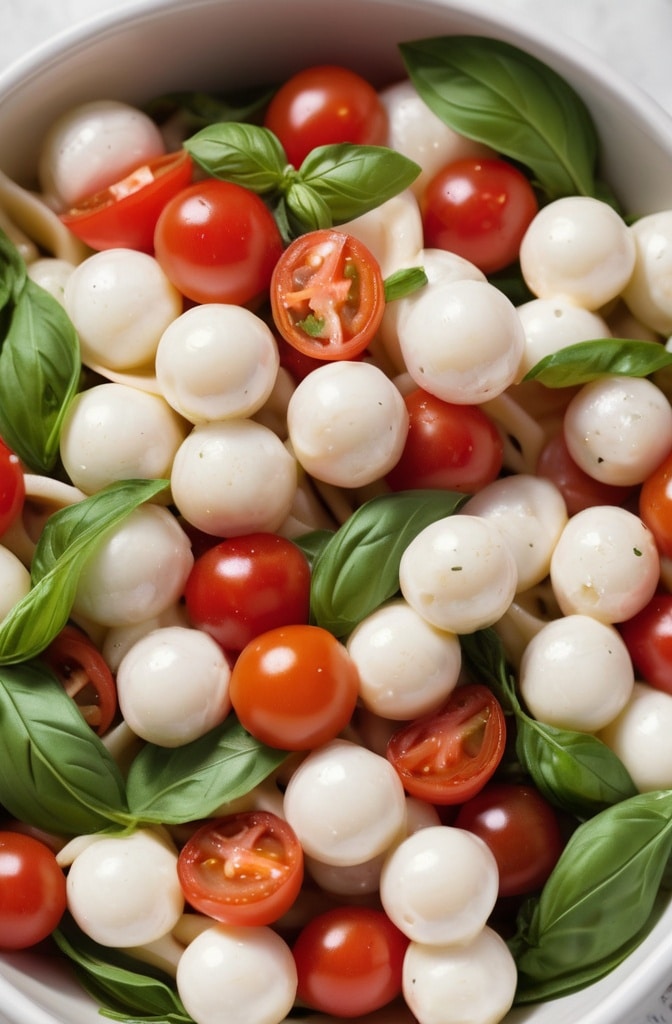
I’ve spent countles hours since then perfecting my own version, and I’m thrilled to share it with you today. This isn’t just any pasta salad; it’s summer in a bowl – a harmonious blend of juicy tomatoes, creamy mozzarella, fragrant basil, and al dente pasta, all brought together with liquid gold olive oil and a kiss of balsamic. Perfect for everything from lazy weekend lunches to elegant dinner parties.
Ingredients & Substitutions
For the Base:
- 16 oz (450g) short pasta (fusilli, farfalle, or penne work beautifully)
- 1 lb (450g) cherry tomatoes or grape tomatoes, halved
- 8 oz (225g) fresh mozzarella pearls (or a ball cut into bite-sized pieces)
- 1 cup fresh basil leaves, torn or roughly chopped
- 1/2 red onion, thinly sliced (optional)
- 2-3 cloves garlic, minced or microplaned
For the Dressing:
- 1/3 cup (80ml) extra virgin olive oil (the best quality you can afford)
- 2-3 tbsp balsamic vinegar or balsamic glaze
- 1 tsp Dijon mustard
- 1 tsp honey or maple syrup
- Salt and freshly cracked black pepper to taste
- 1/2 tsp dried oregano
- Pinch of red pepper flakes (optional)
When it comes to pasta, the shape matters more than you might think. I prefer fusilli because those little spirals capture pockets of dressing and tiny bits of herbs in their grooves. For a gluten-free option, brown rice or chickpea pasta maintains structural integrity better than corn-based alternatives, which tend to fall apart when chilled.
The mozzarella deserves special attention. Traditional caprese uses fresh buffalo mozzarella, which has an incomparible creaminess. However, the firmer cow’s milk variety (fior di latte) actually holds up better in pasta salad. For a dairy-free version, firm tofu marinated in lemon juice, salt, and nutritional yeast creates a surprisingly effective substitute.
Tomatoes are the heart of this dish. Cherry or grape varieties offer consistent sweetness year-round, but during peak summer, heirloom varieties cut into chunks elevate this dish to something extraordinary. The natural acidity and sweetness in sun-ripened tomatoes creates a perfect balance that makes the whole dish sing.
Step-by-Step Instructions
Preparing the Pasta
- Bring a large pot of water to a rolling boil. Season generously with salt—the water should taste like seawater. This is your only chance to season the pasta itself.
- Cook the pasta until al dente according to package instructions, typically 8-10 minutes. Dont overcook! The pasta will continue absorbing liquid from the dressing, so you want it slightly firmer than you might normally prefer.
- Drain the pasta thoroughly and spread it on a baking sheet to cool. Drizzle with a tablespoon of olive oil and toss gently to prevent sticking. Allow it to cool completely before combining with other ingredients—this prevents the mozzarella from melting and maintains the integrity of the tomatoes.
A common mistake is rinsing pasta with cold water. While this cools it quickly, it also washes away the starches that help the dressing adhere. Instead, the oil-and-spread method preserves both temperature and texture while preventing clumping.
Preparing the Ingredients
- While the pasta cools, prepare your tomatoes. For cherry varieties, halving is sufficient. For larger tomatoes, remove the seeds and excess liquid (save this flavor bomb for deglazing a pan later) before dicing into bite-sized pieces.
- If using a block of mozzarella, tear it rather than cutting it—those irregular edges create more surface area for the dressing to cling to, amplifying flavor in every bite.
- For the onion, after slicing thinly, soak in ice water for 10-15 minutes to mellow the sharpness while maintaining crispness. This small step transforms the onion from a potential palate-wrecker to a complementary background note.
When working with fresh basil, the conventional wisdom of using a sharp knife isn’t always best. Tearing the leaves by hand releases more aromatic oils and prevents the browning that can happen when metal blades trigger oxidation. For smaller leaves, a chiffonade cut works well, but only do this right before serving.
Making the Dressing
- In a small bowl, combine the minced garlic with balsamic vinegar and let it sit for 5 minutes. This mellows the garlic’s sharpness while infusing the vinegar with its essence.
- Whisk in the olive oil slowly to create an emulsion, followed by the Dijon mustard, honey, dried oregano, salt, pepper, and red pepper flakes if using.
- Taste and adjust seasonings. The dressing should be slightly more potent than you’d think necessary—once distributed throughout the salad, the intensity will balance perfectly.
For a creamier variation, incorporate 2 tablespoons of Greek yogurt or mascarpone into the dressing. This creates a richer mouthfeel that beautifully coats each pasta piece without heaviness.
Assembly
- In a large mixing bowl, combine the cooled pasta, prepared tomatoes, mozzarella, and red onion if using.
- Drizzle two-thirds of the dressing over the ingredients and toss gently using wooden spoons or your hands (the best tools for delicate mixing).
- Just before serving, fold in the fresh basil and remaining dressing. Season with additional salt and pepper to taste.
The single biggest mistake with Caprese pasta salad is overmixing. Aggressive stirring breaks down the tomatoes and turns the mozzarella mushy. Instead, think of folding the ingredients together with intention—like gently turning the pages of a precious book.
Cooking Techniques & Science
The magic of Caprese pasta salad lies in understanding ingredient behavior over time. Pasta continues absorbing liquid as it sits, which is why we cook it al dente and why the dressing might seem slightly abundant at first. Tomatoes release liquid when salted, creating an additional component of the dressing that develops as the salad rests.
Acid and salt work together to transform the dish. The acid from tomatoes and balsamic vinegar brightens flavors and cuts through the richness of the mozzarella, while salt enhances everything it touches. But theres a delicate balance—too much acid can “cook” the basil, turning it black, which is why we add it last.
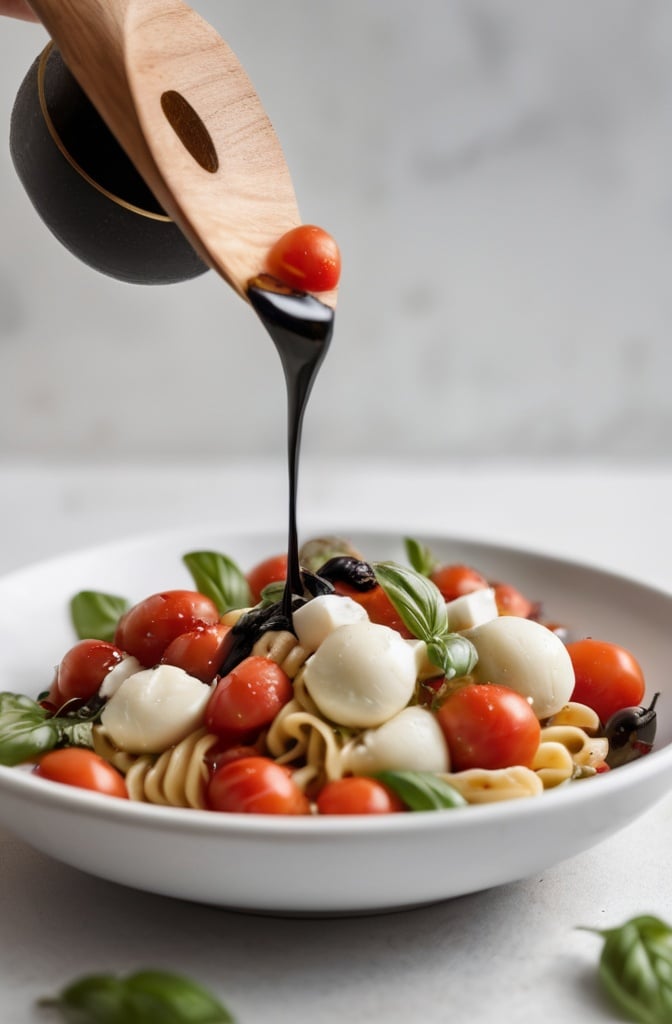
Temperature plays a crucial role in flavor perception. While this salad can be served cold from the refrigerator, allowing it to come to room temperature (about 20 minutes on the counter) awakens the flavors. The olive oil regains its fluidity, the cheese softens slightly, and the overall taste experience becomes more pronounced.
For texture contrast, consider toasting some pine nuts or pangrattato (crispy breadcrumbs toasted with garlic and herbs) to sprinkle over the top just before serving. The crunchiness creates a delightful counterpoint to the tender pasta and soft cheese.
The choice of balsamic matters enormously. Traditional Aceto Balsamico Tradizionale di Modena aged for 12+ years creates depth that younger vinegars can’t match, but it’s also prohibitively expensive for everyday use. A reasonable compromise is a moderately priced balsamic vinegar reduced slowly on the stove until slightly syrupy, which concentrates flavors without concentrating the cost.
Serving & Pairing Suggestions
Caprese pasta salad shines as both a standalone dish and a supporting player. For a complete meal, serve alongside grilled chicken breast marinated simply in lemon, garlic, and herbs. For a vegetarian option, add cannellini beans tossed with lemon zest directly into the salad for protein.
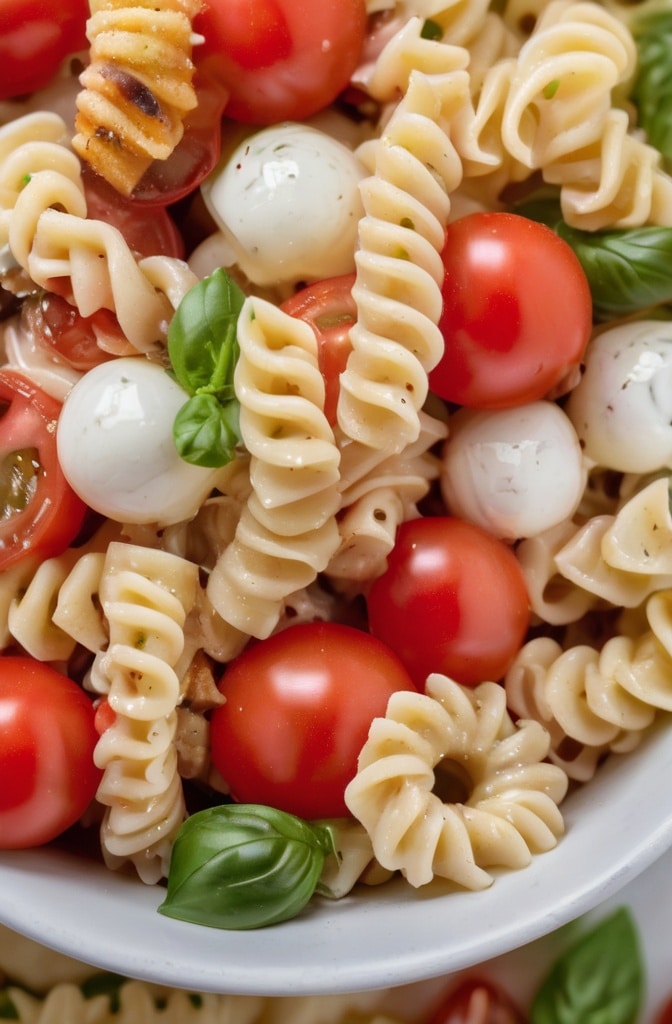
The presentation deserves attention. Rather than serving from the mixing bowl, transfer to a wide, shallow platter where the colors can be appreciated. Garnish with additional basil leaves, a drizzle of your finest olive oil, and a light dusting of flaky sea salt.
Wine pairings should complement rather than compete. A crisp Pinot Grigio from northern Italy or a light Provençal rosé provides perfect balance. For non-alcoholic options, sparkling water infused with cucumber and lemon or an Italian blood orange soda diluted with sparkling water offers refreshing counterpoints.
Make-ahead potential is substantial but requires understanding timing. The salad can be prepared up to 24 hours in advance with one crucial modification: hold back the fresh basil and final seasoning until just before serving. Store in an airtight container, allowing it to come to room temperature before the final assembly.
For an elevated presentation at dinner parties, consider individual portions served in wide-rimmed shallow bowls, with a fresh basil sprig and a single edible flower as garnish. The extra touch transforms a rustic favorite into an elegant first course.
Advanced Variations
While the classic recipe is divine in its simplicity, here are three variations that honor the original while exploring new territories:
Mediterranean Expansion: Add kalamata olives, diced cucumbers, and crumbled feta alongside the traditional ingredients. The saltiness of the olives and feta creates beautiful counterpoints to the sweet tomatoes.
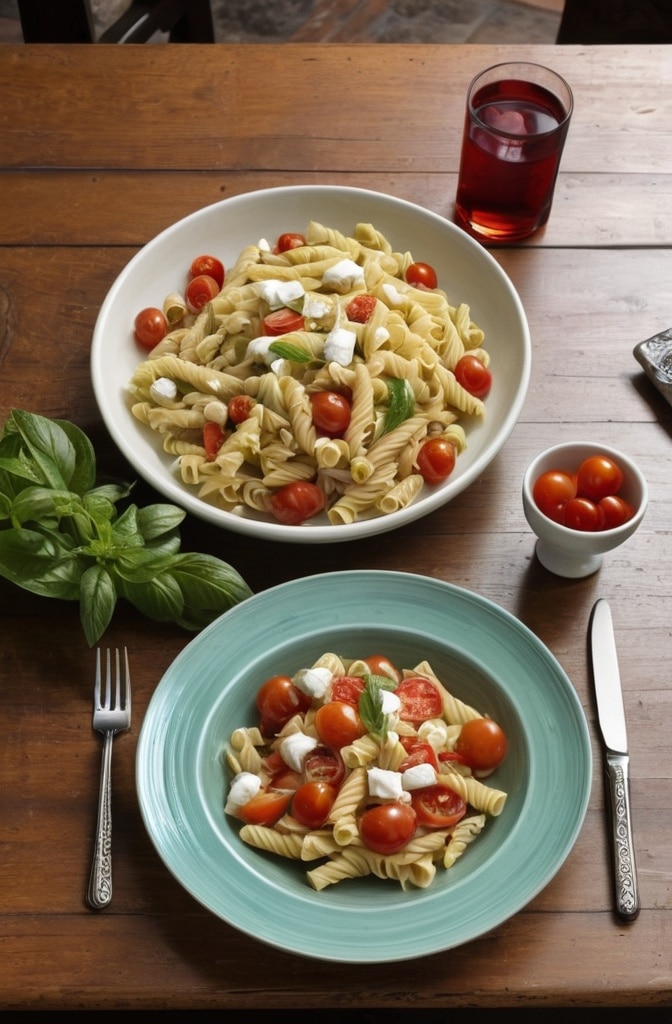
Autumn Caprese: Replace some tomatoes with roasted butternut squash cubes, add toasted walnuts, and swap the mozzarella for smoked scamorza. This variation carries the caprese concept beautifully into cooler months.
Herbal Enhancement: Create an herb oil by blending olive oil with a mixture of basil, parsley, and mint before using it in the dressing. This creates layers of herbaceous notes that complement the fresh basil leaves added at the end.
For entertaining, I often create a “caprese bar” where guests can customize their pasta salad with various additions—grilled vegetables, different cheeses, nuts, and herbs—while maintaining the fundamental caprese trinity of tomato, mozzarella, and basil as the foundation.
Conclusion
The beauty of Caprese pasta salad lies in its deceptive simplicity. What appears straightforward—just pasta, tomatoes, cheese, and basil—becomes extraordinary through attention to detail: the quality of ingredients, the careful balance of temperatures, textures, and timing.
Master this dish, and you’ll have a versatile recipe that adapts to any season or occasion. It embodies the Italian philosophy of “pochi ingredienti, tanto sapore”—few ingredients, much flavor—reminding us that cooking at its finest isn’t about complexity, but about honoring each element and understanding how they interact.
When you taste a perfectly executed Caprese pasta salad, with the acidity of tomatoes, the creaminess of mozzarella, the aromatic punch of basil, and the foundation of perfectly cooked pasta, you’re experiencing something greater than the sum of its parts. You’re tasting summer itself, captured in a bowl, ready to be shared with those you love.
Frequently Asked Question?
Can I make Caprese pasta salad ahead of time?
Yes, but with strategic timing. Prepare all components and dress the pasta, tomatoes, and mozzarella up to 24 hours ahead, but add the fresh basil just before serving to prevent browning. Allow refrigerated salad to come to room temperature for about 20 minutes before serving to reawaken flavors.
Why does my pasta salad seem dry the next day?
Pasta continues absorbing liquid as it sits. To revitalize leftover salad, drizzle with a bit of olive oil and a tiny splash of balsamic, then gently toss. This refreshes the dressing without requiring a complete remake.
Is there a way to prevent the mozzarella from becoming rubbery?
Absolutely. The key is using room-temperature mozzarella when preparing the salad and storing leftovers properly. When refrigerated, the cheese’s proteins tighten, creating that rubber-like texture. Allowing the cheese to warm slightly before serving restores its creamy texture.
Can I use regular tomatoes instead of cherry tomatoes?
Yes, but preparation differs. With larger tomatoes, remove seeds and excess juices first (reserve for another use), then dice the flesh. This prevents the salad from becoming watery while maintaining the essential tomato flavor.
What’s the best way to maintain the vibrant green color of basil?
Tear or cut basil just before adding to the salad, and never subject it to heat or acid until the last moment. For maximum visual impact, reserve some of the most beautiful leaves for garnishing the top of the dish just before bringing it to the table.
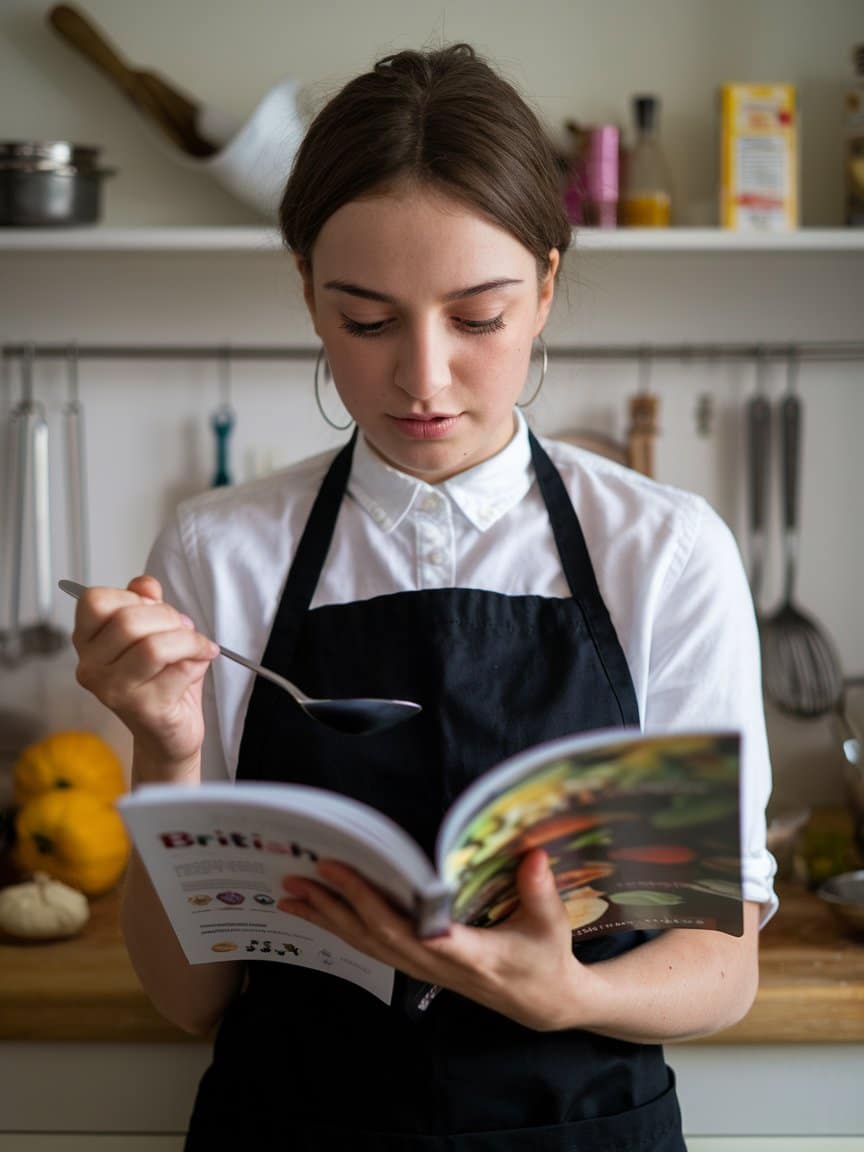
Veronica is a passionate food enthusiast with over three years of experience in exploring and writing about diverse cuisines. Her expertise lies in reviewing restaurants, sharing creative recipes, and discovering the latest food trends. As the voice behind FoodieRecap.com, Anju brings fresh perspectives and culinary insights to her audience.
